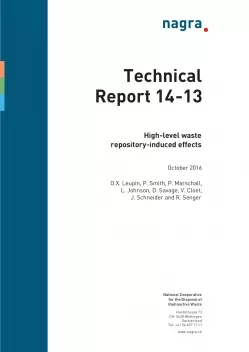
Technical Report NTB 14-13
High-level waste repository-induced effects
This status report aims at describing and assessing the interactions of the radioactive waste emplaced in a high-level waste (HLW) repository with the engineered materials and the Opalinus Clay host rock. The Opalinus Clay has a thickness of about 100 m in the proposed siting regions. Among other things the results are used to steer the RD&D programme of Nagra. The repository-induced effects considered in this report are of the following broad types:
- Thermal effects: i.e. effects on the host rock and engineered barriers arising principally from the heat generated by the waste
- Rock-mechanical effects: i.e. effects arising from the mechanical disturbance to the rock caused by the excavation of the emplacement rooms and other underground structures
- Hydraulic and gas-related effects: i.e. the effects of repository resaturation and of gas generation, e.g. due to the corrosion of metals within the repository, on the host rock and engineered barriers
- Chemical effects: i.e. chemical interactions between the waste, the engineered materials and the host rock, with a focus on chemical effects of the waste and engineered materials on the host rock
The assessment of the repository-induced effects shows that detrimental chemical and mechanical impacts are largely confined to the rock immediately adjacent to the excavations, thermal impacts are controllable by limiting the heat load and gas effects are limited by ensuring acceptably low gas production rates and by the natural tendency of the gas to escape along the excavations and the excavation damaged zone (EDZ) rather than through the undisturbed rock. Specific measures that are part of the current reference design are discussed in relation to their significance with respect to repository-induced effects.
The SF/HLW emplacement rooms (emplacement drifts) are designed, constructed, operated and finally backfilled in such a way that formation of excavation damaged zones is limited. Specifically this is achieved by restricting the size of the excavations and the depth of the repository, using a low-deformation, controlled construction and excavation method and by the fact that the excavations will be backfilled relatively soon after construction with a swelling backfill material. At expected repository depths, the rooms will need to be supported to ensure stability and worker protection; this will prevent rock falls and further extension of the EDZ. Based on the modelling results, it can be concluded that the extent of the EDZ around the HLW emplacement rooms will not exceed a thickness of one room diameter and that the average hydraulic conductance of the EDZ around emplacement rooms, access tunnels and shafts will not exceed a value of 10-7 m3/s. Self-sealing of the EDZ and low hydraulic gradients along the tunnels will result in negligible radionuclide transport by the EDZ pathway.
The relevant chemical interactions are taken into account when designing and assessing the performance of a HLW repository. In the current reference design, tunnel support is provided by a concrete liner. It is expected that degradation of the liner and corrosion of the steel canister and other supporting structures will lead to some alteration of the bentonite buffer and Opalinus Clay. These detrimental effects are taken into account in dose calculations and have been found not to have a significant impact on the calculated dose rates.
For the reference gas generation rates, the gas transport capacity of the Opalinus Clay is sufficiently high to dispel gas without invoking pathway dilation as a gas transport mechanism and without causing damage to the rock. Even if potential transport pathways for gas along the excavations and EDZ are disregarded, overpressures that would lead to the onset of pathway dilation are reached only in cases combining conservative gas generation rates with a low-permeability host rock, and these overpressures are still insufficient to cause rock damage. It is noted that such calculations do not incorporate transport of gas along the EDZ, which has a lower gas entry pressure than undisturbed Opalinus Clay.
The effects of heat from the HLW on the engineered and geological barriers cannot be completely eliminated, but can be kept low by ensuring a sufficient duration of interim storage, limiting canister loading and a suitable canister emplacement density.
